Cenu za klubka počítáme podle spotřeby při výrobě modelu v nejmenší velikosti a nejlevnější variantě příze. Rádi byste ještě lepší cenu? Třeba ji najdete mezi DROPS Deals!
Daisy Delight Cardigan
Dětský propínací svetr s kruhovým sedlem s vroubkovým a norským vzorem s kytičkami pletený shora dolů z příze DROPS Merino Extra Fine nebo DROPS Lima. Velikost 3-12 let.
DROPS Design: model č. me-051-bn
Skupina přízí B
-------------------------------------------------------
VELIKOST:
3/4 - 5/6 - 7/8 - 9/10 - 11/12 let
Velikost v cm:
98/104 - 110/116 - 122/128 - 134/140 - 146/152
MATERIÁL:
DROPS MERINO EXTRA FINE firmy Garnstudio (spadá do skupiny přízí B)
250-300-300-350-350 g, barva č. 34, vřes
50-50-50-50-50 g, barva č. 01, smetanová
50-50-50-50-50 g, barva č. 30, zlatá
nebo:
DROPS LIMA firmy Garnstudio (spadá do skupiny přízí B)
250-300-300-350-350 g, barva č. 6273, pink
50-50-50-50-50 g, barva č. 0100, smetanová
50-50-50-50-50 g, barva č. 2923, žlutá
ZKUŠEBNÍ VZOREK:
21 ok na šířku a 28 řad na výšku lícovým žerzejem = 10 x 10 cm.
JEHLICE:
DROPS PONOŽKOVÉ JEHLICE a KRUHOVÁ JEHLICE č.4, dlouhá 40 a 60 cm.
Uvedená síla jehlic je pouze orientační. Máte-li ve svém zkušebním vzorku více ok na 10 cm, použijte jehlice silnější. Pokud máte naopak méně ok na 10 cm, použijte jehlice slabší.
DROPS DŘEVĚNÝ KNOFLÍK, Kokos č. 516: 5-5-6-6-6 ks.
-------------------------------------------------------
Náhradní příze – Podívejte se, jak změnit přízi
Skupina přízí A až F – Neměňte návod, změňte přízi
Spotřeba příze při použití náhradní příze – Využijte náš převodník
-------------------------------------------------------
Cenu za klubka počítáme podle spotřeby při výrobě modelu v nejmenší velikosti a nejlevnější variantě příze. Rádi byste ještě lepší cenu? Třeba ji najdete mezi DROPS Deals!
- Česky
- Dansk
- Deutsch
- Eesti keel
- English (UK/cm)
- English (US/in)
- Español
- Français
- Íslenska
- Italiano
- Magyar
- Nederlands
- Norsk
- Polski
- Português
- Suomi
- Svenska
- English (UK/cm), Bulgaria
- English (UK/cm), Croatia
- English (UK/cm), Greece
- English (UK/cm), Latvia
- English (UK/cm), Lithuania
- English (UK/cm), Romania
- English (UK/cm), Slovenia
- Česky, Slovakia
Návod
VYSVĚTLIVKY:
----------------------------------------------------------
VROUBKOVÝ VZOR:
1 vroubek = 2 řady hladce. Pleteme stále hladce, lícové i rubové řady.
VZOR:
Viz schémata A.1 a A.2. Zvolte si schéma pro požadovanou velikost. Zobrazeny jsou všechny řady vzoru nahlížené z lícové strany.
TIP – PŘIDÁVÁNÍ 1:
Abychom vypočítali, jak často musíme přidávat, vydělíme celkový počet ok na jehlici (např. 72 ok) počtem ok, která potřebujeme přidat (tj. 17), takže 72 : 17 = 4,2.
V tomto případě tedy 1x nahodíme za každým zhruba 4. okem. V následující řadě pleteme nahození za zadní nit, aby se v pletenině netvořily dírky.
TIP – PŘIDÁVÁNÍ 2 (boky):
Začínáme 1 oko před značkou: 1x nahodíme, 2 oka upleteme hladce (značka leží mezi nimi), 1x nahodíme (= přidali jsme 2 oka). V následující řadě pleteme nahození za zadní nit, aby se v pletenině netvořily dírky. Přidaná oka pak dál pleteme lícovým žerzejem.
TIP – UJÍMÁNÍ (podpaží, rukávy):
Na každé straně značky ujmeme 1 oko, takto – začínáme 3 oka před značkou: 2 oka spleteme hladce, 2 oka upleteme hladce (značka leží mezi nimi), 1 oko sejmeme hladce, 1 oko upleteme hladce a sejmuté přes ně přetáhneme (= ujmuli jsme 2 oka).
KNOFLÍKOVÉ DÍRKY:
Knoflíkové dírky vyplétáme v pravé léze (na svetr se díváme, jako by byl oblečený). 1 DÍRKA = v rubové řadě spleteme 2. a 3. oko od okraje dílu a 1x nahodíme. V následující řadě pleteme nahození hladce – vznikne dírka.
První knoflíkovou dírku vypleteme ve výši 1 cm (tj. v lemu průkrčníku). Každou z dalších 4-4-5-5-5 dírek pak vyplétáme vždy po 6-6-6-7-7 cm výšky.
-------------------------------------------------------
POPIS PRÁCE:
-------------------------------------------------------
SVETR - JAK BUDEME POSTUPOVAT:
Pleteme v řadách na kruhové jehlici, shora dolů. Rukávy pleteme v kruhových řadách na krátké kruhové jehlici či ponožkových jehlicích.
SEDLO:
Na kruhovou jehlici č.4 nahodíme vřesovou přízí 72-76-80-86-92 ok a upleteme 2 VROUBKY – viz výše (začínáme lícovou řadou). Pamatujeme na vyplétání KNOFLÍKOVÝCH DÍREK v pravé léze – viz výše. Pak pleteme 1 lícovou řadu hladce a SOUČASNĚ přidáme rovnoměrně 17-19-21-23-24 ok – viz TIP – PŘIDÁVÁNÍ 1 = 89-95-101-109-116 ok. Upleteme 1 rubovou řadu hladce. Tuto řadu si označíme značkou a NYNÍ MĚŘÍME DÍL OD TOHOTO MÍSTA!
V následující lícové řadě začneme plést vzor A.1 a A.2, takto: 5 ok VROUBKOVÝM VZOREM (= léga), vzor A.1 (= 1 oko), vzor A.2 (= 13-14-15-14-15 sekvencí vzoru), končíme 5 oky légy vroubkovým vzorem.
Po dokončení celé sekvence vzoru A.1 a A.2 (na výšku), máme na jehlici 219-235-251-263-281 ok. V následující lícové řadě přidáme rovnoměrně 3-3-5-1-5 ok = 222-238-256-264-286 ok.
Pokračujeme lícovým žerzejem s 5 oky légy vroubkovým vzorem na každé straně až do výše 15-15-16-17-18 cm od značky. Následující lícovou řadu pleteme takto: 5 ok légy vroubkovým vzorem, 31-33-36-37-38 ok lícovým žerzejem (= přední díl), následujících 44-48-51-53-62 ok odložíme na pomocnou jehlici (= rukáv), nahodíme 6 nových ok (= podpaží), 62-66-72-74-76 ok upleteme lícovým žerzejem (= zadní díl), dalších 44-48-51-53-62 ok odložíme na pomocnou jehlici (= rukáv), nahodíme 6 nových ok (= podpaží), 31-33-36-37-38 ok upleteme hladce (= přední díl) a 5 ok légy vroubkovým vzorem.
TRUP:
Na jehlici máme 146-154-166-170-174 ok.
NYNÍ MĚŘÍME DÍL OD TOHOTO MÍSTA!
Doprostřed 6 nových ok v podpaží na každé straně dílu vložíme značku (= boky). Pleteme v řadách lícovým žerzejem s 5 oky légy vroubkovým vzorem na každé straně. Ve výši 3 cm přidáme na obou stranách obou značek 1 oko (= celkem 4 oka) – viz TIP – PŘIDÁVÁNÍ 2! Toto přidávání opakujeme vždy po 3-4-5-6-7 cm výšky, celkem 3x = na jehlici máme 158-166-178-182-186 ok. Pokračujeme v pletení jako dosud až do výše 12-16-19-22-25 cm. Pak upleteme 1 lícovou řadu a SOUČASNĚ přidáme rovnoměrně 10-10-10-10-10 ok (přidáváme mimo obě légy) = 168-176-188-192-196 ok.
Následující lícovou řadu pleteme takto: 5 ok légy vroubkovým vzorem, 2 oka obrace, *2 oka hladce, 2 obrace*, *-* opakujeme až po posledních 5 ok a končíme 5 oky légy vroubkovým vzorem. Takto pleteme pružný lem do výše 3 cm. V následující lícové řadě pak všechna oka dle vzoru uzavřeme. Přízi odstřihneme a zapošijeme.
RUKÁV:
Odložená oka jednoho rukávu vrátíme z pomocné jehlice zpět na krátkou kruhovou jehlici/ponožkové jehlice č.4 (= 44-48-51-53-62 ok) a navíc k nim nabereme po 1 oku z každého ze 6 nových ok v podpaží (= 50-54-57-59-68 ok). Doprostřed těchto 6 ok vložíme značku. Pleteme v kruhových řadách lícovým žerzejem. Ve výši 2 cm ujmeme na každé straně značky 1 oko – viz TIP - UJÍMÁNÍ. Toto ujímání opakujeme vždy po 4-3,5-4-4-3,5 cm výšky, celkem 5-7-7-8-10x = na jehlici máme 40-40-43-43-48 ok. Pokračujeme lícovým žerzejem až do výše 22-27-30-34-37 cm. Pak upleteme 1 kruhovou řadu a SOUČASNĚ přidáme rovnoměrně 4-4-5-5-4 ok = 44-44-48-48-52 ok. Nyní pleteme lem pružným vzorem 2/2. Když je lem vysoký 3 cm, všechna oka volně dle vzoru uzavřeme. Přízi odstřihneme a zapošijeme.
Stejným způsobem upleteme i druhý rukáv.
DOKONČENÍ:
Sešijeme otvory v podpaží. Na levou légu přišijeme knoflíky.
Schéma

|
= lícový žerzej (líc hladce, rub obrace) vřesovou přízí |

|
= rubový žerzej (líc obrace, rub hladce) vřesovou přízí |

|
= lícový žerzej (líc hladce, rub obrace) smetanovou přízí |

|
= lícový žerzej (líc hladce, rub obrace) zlatou přízí |

|
= 1x nahodíme mezi 2 oky, v následující řadě pleteme nahození za zadní nit, aby se v pletenině netvořily dírky |

|
= v této řadě přidáváme uprostřed schématu - dejte pozor, aby vzor v následujících řadích správně navazoval |

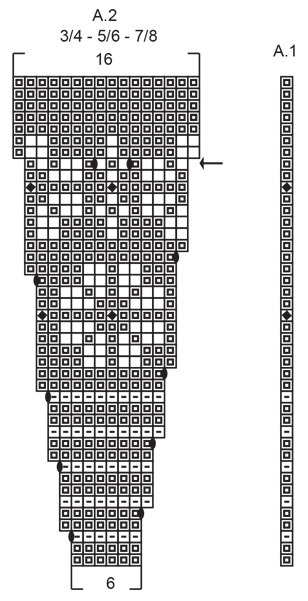

Jak můžete zacházet s našimi návody? Můžete sdílet DROPS návody online, s použitím původní fotky, uvedením originální příze, jména a čísla modelu. Ale JE ZAKÁZÁNO jakkoli reprodukovat či kopírovat celé návody v digitální podobě. Obchody s přízí mohou využívat databázi DROPS návodů k podpoře prodeje našich produktů. Návody si můžete vytisknout v libovolném počtu kopií. Žádáme vás o jedinou věc: nedělejte žádné úpravy a změny v tištěném originálu, ani původní návod v tištěné podobě nijak nedoplňujte. A také respektujte pravidlo DROPS a návody poskytujte klientům zdarma. Vydavatele, kteří by rádi zveřejnili naše návody v tištěných knihách nebo časopisech, prosíme, aby nás kontaktovali - rádi jim poskytneme podrobnější informace. Prodej výrobků vytvořených podle návodů DROPS je povolen pouze v případě, že jde o prodej jednotlivých kusů nebo výrobu na zakázku. Větší komerční využití návodů dovoleno není. U každého výrobku musí být rovněž jasně a zřetelně uvedeno, že jde o výrobek podle modelu z kolekce DROPS DESIGN. Opatřit nášivkami či visačkami oděvy, které využívají DROPS DESIGN je podmíněno uvedením následujícího textu: "Model DROPS DESIGN vytvořil/a...(doplňte jméno člověka, který oděv vyrobil)". Použití fotografií DROPS pro marketingové účely/prodej je povoleno výhradně v přímé souvislosti s použitím/prodejem přízí, pomůcek a doplňků DROPS. Fotografie nesmí být vystřižené, ořezané ani jinak upravené a logo na nich musí zůstat zřetelně viditelné.
Vyhrazujeme si právo kdykoli stáhnout povolení k užívání, a to bez udání důvodu.
Každý náš návod je doprovázen speciálními video-ukázkami, které vás navedou.
Tyto podrobné video-návody vás povedou "krok za krokem":
Proč je napětí příze u pletení/ háčkování tak důležité?
Napětí příze (hustota úpletu) určuje konečné míry vaší práce a obvykle se měří na vzorku 10 x 10 cm. Spočítáme takto: počet ok na šířku x počet řad na výšku - např.: 19 ok x 26 řad = 10 x 10 cm.
Napětí příze je velmi individuální; někteří lidé pletou/ háčkují volně, zatímco jiní značně utahují. Napětí příze přizpůsobíte změnou velikosti jehlic, proto doporučenou velikost jehlic berte pouze jako vodítko! Je důležité, abyste zajistili, že VAŠE napětí příze odpovídá napětí uvedenému ve vzoru. Pokud budete pracovat s jiným napětím příze než je uvedeno ve vzoru, vaše spotřeba příze a konečné rozměry vaší práce se budou lišit.
Napětí příze také určuje, které příze je možné vzájemně zaměňovat. Pokud dosáhnete stejného napětí příze, můžete snadno zaměnit jednu přízi za druhou.
Viz lekce DROPS: Jak změřit napětí příze/ zkušební vzorek
Viz video DROPS: Jak vypracovat zkušební vzorek napětí příze
Jak zjistím, kolik klubek příze potřebuji?
Požadované množství příze je uvedeno v gramech, např.: 450 g. Pro výpočet potřebného množství klubek musíte nejdříve vědět, kolik gramů je v 1 klubku (25 g, 50 g nebo 100 g). Tyto informace jsou dostupné po kliknutí na jednotlivé druhy přízí na našich stránkách. Vydělte požadované množství množstvím každého klubka. Pokud má například klubko 50 g (nejběžnější množství), výpočet bude následující: 450 / 50 = 9 klubek.
Mohu použít jinou přízi než jaká je doporučena u vybraného vzoru?
Při záměně jedné příze za druhou je důležité, aby napětí příze (hustota úpletu) při pletení/ háčkování zůstala stejná. To proto, aby rozměry hotového oděvu odpovídaly poskytnutému náčrtu. Stejného napětí příze je snazší dosáhnout pomocí přízí ze stejné skupiny. Je také možné pracovat s vícero vlákny tenčí příze najednou, a tak dosáhnout stejného napětí jako při práci se silnější přízí. Vyzkoušejte náš převodník přízí. Doporučujeme vám si vždy vypracovat zkušební vzorek (swatch).
POZNÁMKA: při záměně přízí se může oděv výrazně lišit od oděvu na fotografii, to díky rozdílným vlastnostem a složení každé příze.
Viz lekce DROPS: Mohu použít jinou přízi než je uvedena ve vzoru?
Co to jsou skupiny přízí DROPS?
Všechny naše příze jsou rozděleny do skupin přízí (od A do F) podle síly a napětí příze – skupina A zahrnuje nejtenčí příze a skupina F ty nejsilnější. Toto vám usnadní hledání alternativních přízí k našim vzorům, pokud byste chtěli přízi vyměnit. Všechny příze stejné skupiny mají podobné napětí příze (hustotu úpletu) a můžete je tak snadno vzájemně nahrazovat. Jednotlivé druhy přízí se nicméně liší složením a vlastnostmi, hotové dílo tak získá na jedinečnosti jak na pohled tak na omak.
Kliknutím zde zobrazíte přehled přízí v jednotlivých skupinách.
Jak použít převodník přízí (yarn calculator)?
V horní části všech našich vzorů najdete odkaz na náš převodník přízí (yarn calculator), což je užitečný nástroj, pokud byste chtěli použít jinou než doporučenou přízi. Vyplněním druhu příze, kterou si přejete vyměnit, množství (ve vaší velikosti) a počtu vláken, vám převodník nabídne vhodné alternativní příze se stejným napětím příze (hustotou úpletu). Dále vám prozradí, kolik alternativní příze budete potřebovat a zda budete muset pracovat s vícero vlákny najednou. Většina klubek má hmotnost 50 g (některá 25 g nebo 100 g).
Pokud je vzor vypracován ve vícero barvách najednou, bude nutné každou barvu vypočítat samostatně. Stejně tak, pokud je vzor vypracován s několika vlákny různých přízí (například 1 vlákno alpaky a 1 vlákno Kid-Silk), budete muset najít alternativy jednotlivě, tedy pro každou zvlášť.
Kliknutím zde zobrazíte náš převodník přízí
Proč u vzorů stále uvádíte příze, které se již nevyrábí?
Protože různé příze mají různé vlastnosti a textury, rozhodli jsme se původní přízi v našich vzorech zachovat. Můžete však snadno najít dostupné alternativy mezi našimi ostatními druhy přízí pomocí našeho převodníku nebo si jednoduše vybrat přízi ze stejné skupiny přízí.
Je možné, že někteří prodejci mají přízi stále na skladě, nebo že někdo má doma pár klubek, pro která by rád našel vzory.
Převodník přízí vám nabídne jak alternativní přízi, tak i její požadované množství.
Jakou mám zvolit velikost?
Pokud si nejste jistí jakou velikost vypracovat, můžete například změřit oděv, který již vlastníte a jehož velikost se vám líbí. Následně si zvolte velikost porovnáním těchto mír s těmi v tabulce velikostí vybraného vzoru.
Tabulku velikostí najdete ve spodní části vzoru.
Viz lekce DROPS: Jak číst tabulku velikostí
Proč mi nevychází velikost zkušebního vzorku na doporučené síle jehlic?
Velikost jehlic uvedená ve vzoru slouží pouze jako vodítko, důležité je dodržet napětí příze (hustotu úpletu). A protože napětí příze je velmi individuální, budete muset upravit velikost jehlic tak, abyste zajistili stejné napětí jaké je uvedené ve vzoru – možná budete muset přizpůsobit sílu jehlic o 1 či dokonce 2 velikosti abyste dosáhli správného napětí. Za tímto účelem vám doporučujeme vypracovat zkušební vzorky.
Pokud byste pracovali s jiným napětím příze než je uvedeno, rozměry hotového oděvu se mohou od rozměrů uvedených na náčrtu lišit.
Viz lekce DROPS: Jak změřit napětí příze/ zkušební vzorek
Viz video DROPS: Jak vypracovat zkušební vzorek
Proč je vzor vypracován shora dolů?
Práce s oděvem shora dolů poskytuje větší flexibilitu a prostor pro individuální úpravy. Například je snazší si oděv v průběhu práce vyzkoušet a také upravit délku sedla a průramků.
Návody vše pečlivě vysvětlují krok za krokem, ve správném pořadí. Schémata jsou přizpůsobena směru pletení a vypracována jako obvykle.
Jak správně číst schéma u pletení?
Schéma zobrazuje všechny řady/ kruhové řady, a každé oko jak se jeví při pohledu z lícové strany. Čte se zdola nahoru, zprava doleva. 1 čtvereček = 1 oko.
Při práci v řadách (tam a zpět) je každá lichá řada řadou lícovou a každá sudá řada je řadou rubovou. Při práci v rubových řadách je nutné vypracovávat schéma obráceně: zleva doprava, hladká oka pleteme obrace, oka pletená obrace vypleteme hladce atd.
Při práci v kruhových řadách je každá řada řadou lícovou a schéma je tedy ve všech řadách vypracováno zprava doleva.
Viz lekce DROPS: Jak číst schémata u pletení
Jak správně číst schéma u háčkování?
Schéma zobrazuje všechny řady/ kruhové řady, a každé oko jak se jeví při pohledu z lícové strany. Vypracovává se zdola nahoru, zprava doleva.
Při práci v řadách (tam a zpět) je každá lichá řada řadou lícovou a každá sudá řada je řadou rubovou. Při práci v rubových řadách je nutné vypracovávat schéma obráceně: zleva doprava.
Při práci v kruhových řadách je každá řada řadou lícovou a schéma je tedy ve všech řadách vypracováno zprava doleva.
Při práci s kruhovým schématem začínáme uprostřed a postupujeme směrem proti směru hodinových ručiček, řadu po řadě.
Řady obvykle začínají daným počtem řetízkových ok (ekvivalentní výšce následujícího oka), což bude buď znázorněno ve schématu nebo vysvětleno ve vzoru.
Viz lekce DROPS: Jak číst schémata u háčkování
Jak vypracovat několik schémat zároveň v jedné řadě/ kruhové řadě?
Pokyny pro práci s vícero schématy zároveň ve stejné řadě/kruhové řadě budou často popsány takto: „háčkujeme vzor A.1, A.2, A.3 celkem 0-0-2-3-4x". To znamená, že A.1 vypracujete jednou, následně A.2 vypracujete jednou a A.3 opakujete (na šířku) tolikrát, kolikrát je pro vaši velikost stanoveno – v tomto případě takto: S = 0 krát, M = 0 krát, L=2 krát, XL= 3 krát a XXL = 4 krát.
Se schématy se pracuje jako obvykle: začněte první řadou v A.1, poté vypracujte první řadu v A.2 atd.
Viz lekce DROPS: Jak číst schémata u pletení
Viz lekci DROPS: Jak číst schémata u háčkování
Proč jsou rukávy u větších velikostí kratší?
Celková šířka oděvu (od zápěstí k zápěstí) bude u větších velikostí větší, přestože rukávy jsou kratší. Větší velikosti mají delší průramky a širší náramenice, aby dobře seděly pro všechny velikostech.
Odkud měřím délku oděvu?
Rozměry na náčrtu/ schématu poskytují informace k celkové délce oděvu. Pokud se jedná o svetr nebo kabátek, délka se měří od nejvyššího bodu na náramenici nejblíže výstřihu směrem dolů ke spodní části oděvu. NENÍ měřeno od vrcholu ramene. Stejně se měří i délka sedla, od nejvyššího bodu náramenice dolů k místu, kde se sedlo dělí na trup a rukávy.
U kabátků, pokud není výslovně uvedeno jinak, se nikdy neměří délka na vnější straně légy. Vždy měřte délku na vnitřní straně.
Viz lekce DROPS: Jak číst schéma
Co znamená opakování?
Schémata se často opakují dokola nebo na výšku. 1 opakování na schématu tak, jak se jeví ve vzoru. Pokud je uvedeno vypracujte 5 opakování A.1 v řadě, pak vypracujete A.1 celkem 5 krát po sobě/ vedle sebe v jedné řadě. Pokud je uvedeno vypracujte 2 opakování A.1 svisle/ na výšku, vypracujte celé schéma jednou, následně začněte znovu od počátku následující řady a vypracujte celé schéma ještě jednou.
Proč je počet počátečních nahozených ok vyšší než počet, s kterým dále pracujeme?
Řetízková oka jsou o něco užší než sloupky. Abyste předešli příliš staženým okům nahozeného okraje, jednoduše uháčkujte více ok řetízku. Počet ok bude v následující řádě upraven tak, aby odpovídal vzoru a náčrtu.
Proč při práci shora dolů přidáváme oka pro pružný lem?
Pružný lem se oproti například lícovému žerzeji jeví mnohem staženější. Přidáním ok před vypracováním lemu se vyhnete viditelnému rozdílu v šířce přechodu mezi pružným lemem a zbytkem trupu.
Proč před uzavíráním lemu přidáváme oka?
Je snadné uzavřít lem příliš pevně. Nahazováním ok při uzavírání lemu (a současným uzavíráním těchto nahození) předejdete příliš utaženému okraji.
Viz video DROPS: Jak uzavřít pomocí nahození (yo)
Jak střídavě ujmout/ přidat v každé 3. a 4. řadě/ kruhové řadě?
Pro dosažení rovnoměrného přidání (nebo ujmutí) můžete přidat např.: každou 3. a 4. řadu střídavě takto: vypracujte 2 řady a přidejte v 3. řadě, vypracujte 3 řady a přidejte ve 4. Takto opakujte až po poslední přidávání..
Viz lekce DROPS: Přidávání či ujímání 1 oka střídavě v každé 3. a 4. řadě
Jak vypracuji kabátek v kruhových řadách namísto v řadách (tam a zpět)?
Pokud dáváte přednost práci v kruhových řadách namísto v řadách (tam a zpět), můžete samozřejmě vzor přizpůsobit a to tak, že přidáte můstky doprostřed přední části (obvykle 5 ok). Dále pak postupujete podle pokynů. Kde byste normálně otočili práci a pracovali z rubové strany, jednoduše pokračujete dál přes můstek v kruhových řadách. Nakonec kabátek rozstřihnete, naberete stehy pro vypracování légy a zakryjete rozstřižené okraje.
Viz video DROPS: Jak uplést a rozstřihnout můstek
Mohu vypracovat svetr v řadách (tam a zpět) namísto v kruhových řadách?
Pokud dáváte přednost práci v řadách (tam a zpět) namísto v kruhových řadách, můžete samozřejmě vzor přizpůsobit a to tak, že jednotlivé díly vypracujete samostatně a na konci je sešijete dohromady. Rozdělte počet ok trupu na polovinu, přidejte na každé straně 1 krajové oko (pro sešití) a vypracujte přední a zadní díl odděleně.
Viz lekce DROPS: Mohu vzor na kruhových jehlicích přizpůsobit rovným jehlicím?
Proč se popis vzoru mírně liší od modelu na fotografii?
Aby se zachovaly správné proporce, opakování vzoru se může v různých velikostech mírně lišit. Pokud nepracujete se stejnou velikostí v jaké je i oděv na fotografii, může se ten váš mírně lišit. Vzor byl pečlivě navržen a upraven tak, aby celkový dojem z oděvu zůstal stejný ve všech velikostech.
Dodržujte proto pokyny a schémata pro vaši velikost!
Jak změním oděv z dámské velikosti na pánskou?
Pokud jste našli vzor, který se vám líbí a který je k dispozici v dámské velikosti, není příliš těžké jej přizpůsobit velikosti pánské. Největší rozdíl bude v délce rukávů a trupu. Začněte pracovat na dámské velikosti o které si myslíte, že by seděla přes hrudník. Dodatečná délka bude vypracována těsně před uzavřením pro průramky. Pokud je vzor vypracován shora dolů, můžete přidat délku hned za průramky nebo před prvním ujmutím na rukávu.
Pokud jde o dodatečné množství příze, bude záležet na přidané délce, ale je lepší mít více klubek než-li méně.
Jak předejít línání u chlupatého oděvu?
Všechny příze mají přebytečná vlákna (z výroby), která mohou žmolkovat či odpadat. Česané příze (tj. chlupatější příze) mají více těchto volných, nadbytečných vláken, což způsobuje větší línání.
Línání také závisí na tom, co nosíme pod nebo přes oděv a zda to táhne vlákna příze. Není proto možné zaručit, že nedojde k žádnému línání
Níže je několik tipů, jak dosáhnout nejlepších výsledků při práci s chlupatější přízí:
1. Když je oděv hotový (než ho vyperete), silně s ním protřepejte, aby se volnější chloupky uvolnily. POZNÁMKA: NEPOUŽÍVEJTE čistící váleček na textil, kartáč ani jinou metodu, která tahá za přízi.
2. Oděv vložte do plastového sáčku a vložte jej do mrazáku – nízká teplota způsobí, že se vlákna k sobě méně přichytí a přebytečná vlákna se snadněji odloučí.
3. Ponechte několik hodin v mrazáku, než jej vyjmete a znovu protřepete.
4. Oděv perte podle pokynů na štítku příze.
Proč se na mé pletenině tvoří žmolky?
Žmolkování je přirozený proces, ke kterému dochází i u těch nejexkluzivnějších vláken. Je to přirozená známka opotřebení, kterému jde jen těžko předejít. Opotřebení je nejviditelnější v místech s vysokým třením, jako je podpaží či lemy.
Váš oděv může vypadat opět jako nový, když žmolky odstraníte pomocí kartáče na šaty nebo speciálního strojku - odžmolkovače.
Mezitím si můžete pročíst otázky a odpovědi, které k tomuto modelu položili ostatní, nebo navštívit skupinu DROPS Workshop na Facebooku, kde vám může poradit některá spřízněná duše!
Mohly by se vám líbit...
Daisy Delight Cardigan |
|||||||||||||||||||
 |
 |
||||||||||||||||||
Dětský propínací svetr s kruhovým sedlem s vroubkovým a norským vzorem s kytičkami pletený shora dolů z příze DROPS Merino Extra Fine nebo DROPS Lima. Velikost 3-12 let.
DROPS Children 34-5 |
|||||||||||||||||||
|
---------------------------------------------------------- VYSVĚTLIVKY: ---------------------------------------------------------- VROUBKOVÝ VZOR: 1 vroubek = 2 řady hladce. Pleteme stále hladce, lícové i rubové řady. VZOR: Viz schémata A.1 a A.2. Zvolte si schéma pro požadovanou velikost. Zobrazeny jsou všechny řady vzoru nahlížené z lícové strany. TIP – PŘIDÁVÁNÍ 1: Abychom vypočítali, jak často musíme přidávat, vydělíme celkový počet ok na jehlici (např. 72 ok) počtem ok, která potřebujeme přidat (tj. 17), takže 72 : 17 = 4,2. V tomto případě tedy 1x nahodíme za každým zhruba 4. okem. V následující řadě pleteme nahození za zadní nit, aby se v pletenině netvořily dírky. TIP – PŘIDÁVÁNÍ 2 (boky): Začínáme 1 oko před značkou: 1x nahodíme, 2 oka upleteme hladce (značka leží mezi nimi), 1x nahodíme (= přidali jsme 2 oka). V následující řadě pleteme nahození za zadní nit, aby se v pletenině netvořily dírky. Přidaná oka pak dál pleteme lícovým žerzejem. TIP – UJÍMÁNÍ (podpaží, rukávy): Na každé straně značky ujmeme 1 oko, takto – začínáme 3 oka před značkou: 2 oka spleteme hladce, 2 oka upleteme hladce (značka leží mezi nimi), 1 oko sejmeme hladce, 1 oko upleteme hladce a sejmuté přes ně přetáhneme (= ujmuli jsme 2 oka). KNOFLÍKOVÉ DÍRKY: Knoflíkové dírky vyplétáme v pravé léze (na svetr se díváme, jako by byl oblečený). 1 DÍRKA = v rubové řadě spleteme 2. a 3. oko od okraje dílu a 1x nahodíme. V následující řadě pleteme nahození hladce – vznikne dírka. První knoflíkovou dírku vypleteme ve výši 1 cm (tj. v lemu průkrčníku). Každou z dalších 4-4-5-5-5 dírek pak vyplétáme vždy po 6-6-6-7-7 cm výšky. ------------------------------------------------------- POPIS PRÁCE: ------------------------------------------------------- SVETR - JAK BUDEME POSTUPOVAT: Pleteme v řadách na kruhové jehlici, shora dolů. Rukávy pleteme v kruhových řadách na krátké kruhové jehlici či ponožkových jehlicích. SEDLO: Na kruhovou jehlici č.4 nahodíme vřesovou přízí 72-76-80-86-92 ok a upleteme 2 VROUBKY – viz výše (začínáme lícovou řadou). Pamatujeme na vyplétání KNOFLÍKOVÝCH DÍREK v pravé léze – viz výše. Pak pleteme 1 lícovou řadu hladce a SOUČASNĚ přidáme rovnoměrně 17-19-21-23-24 ok – viz TIP – PŘIDÁVÁNÍ 1 = 89-95-101-109-116 ok. Upleteme 1 rubovou řadu hladce. Tuto řadu si označíme značkou a NYNÍ MĚŘÍME DÍL OD TOHOTO MÍSTA! V následující lícové řadě začneme plést vzor A.1 a A.2, takto: 5 ok VROUBKOVÝM VZOREM (= léga), vzor A.1 (= 1 oko), vzor A.2 (= 13-14-15-14-15 sekvencí vzoru), končíme 5 oky légy vroubkovým vzorem. Po dokončení celé sekvence vzoru A.1 a A.2 (na výšku), máme na jehlici 219-235-251-263-281 ok. V následující lícové řadě přidáme rovnoměrně 3-3-5-1-5 ok = 222-238-256-264-286 ok. Pokračujeme lícovým žerzejem s 5 oky légy vroubkovým vzorem na každé straně až do výše 15-15-16-17-18 cm od značky. Následující lícovou řadu pleteme takto: 5 ok légy vroubkovým vzorem, 31-33-36-37-38 ok lícovým žerzejem (= přední díl), následujících 44-48-51-53-62 ok odložíme na pomocnou jehlici (= rukáv), nahodíme 6 nových ok (= podpaží), 62-66-72-74-76 ok upleteme lícovým žerzejem (= zadní díl), dalších 44-48-51-53-62 ok odložíme na pomocnou jehlici (= rukáv), nahodíme 6 nových ok (= podpaží), 31-33-36-37-38 ok upleteme hladce (= přední díl) a 5 ok légy vroubkovým vzorem. TRUP: Na jehlici máme 146-154-166-170-174 ok. NYNÍ MĚŘÍME DÍL OD TOHOTO MÍSTA! Doprostřed 6 nových ok v podpaží na každé straně dílu vložíme značku (= boky). Pleteme v řadách lícovým žerzejem s 5 oky légy vroubkovým vzorem na každé straně. Ve výši 3 cm přidáme na obou stranách obou značek 1 oko (= celkem 4 oka) – viz TIP – PŘIDÁVÁNÍ 2! Toto přidávání opakujeme vždy po 3-4-5-6-7 cm výšky, celkem 3x = na jehlici máme 158-166-178-182-186 ok. Pokračujeme v pletení jako dosud až do výše 12-16-19-22-25 cm. Pak upleteme 1 lícovou řadu a SOUČASNĚ přidáme rovnoměrně 10-10-10-10-10 ok (přidáváme mimo obě légy) = 168-176-188-192-196 ok. Následující lícovou řadu pleteme takto: 5 ok légy vroubkovým vzorem, 2 oka obrace, *2 oka hladce, 2 obrace*, *-* opakujeme až po posledních 5 ok a končíme 5 oky légy vroubkovým vzorem. Takto pleteme pružný lem do výše 3 cm. V následující lícové řadě pak všechna oka dle vzoru uzavřeme. Přízi odstřihneme a zapošijeme. RUKÁV: Odložená oka jednoho rukávu vrátíme z pomocné jehlice zpět na krátkou kruhovou jehlici/ponožkové jehlice č.4 (= 44-48-51-53-62 ok) a navíc k nim nabereme po 1 oku z každého ze 6 nových ok v podpaží (= 50-54-57-59-68 ok). Doprostřed těchto 6 ok vložíme značku. Pleteme v kruhových řadách lícovým žerzejem. Ve výši 2 cm ujmeme na každé straně značky 1 oko – viz TIP - UJÍMÁNÍ. Toto ujímání opakujeme vždy po 4-3,5-4-4-3,5 cm výšky, celkem 5-7-7-8-10x = na jehlici máme 40-40-43-43-48 ok. Pokračujeme lícovým žerzejem až do výše 22-27-30-34-37 cm. Pak upleteme 1 kruhovou řadu a SOUČASNĚ přidáme rovnoměrně 4-4-5-5-4 ok = 44-44-48-48-52 ok. Nyní pleteme lem pružným vzorem 2/2. Když je lem vysoký 3 cm, všechna oka volně dle vzoru uzavřeme. Přízi odstřihneme a zapošijeme. Stejným způsobem upleteme i druhý rukáv. DOKONČENÍ: Sešijeme otvory v podpaží. Na levou légu přišijeme knoflíky. |
|||||||||||||||||||
Vysvětlivky ke schématu |
|||||||||||||||||||
|
|||||||||||||||||||

|
|||||||||||||||||||

|
|||||||||||||||||||

|
|||||||||||||||||||
|
Vyrobili jste si tento nebo nějaký jiný z našich modelů? Přidejte ke svým fotkám na sociálních sítích tag #dropsdesign - díky tomu je uvidíme i my! Potřebujete s tímto návodem poradit?Otevřete-li si návod na stránce garnstudio.com, najdete tam výukových video-ukázek, Komentáře/Dotazy a další užitečné informace. © 1982-2024 DROPS Design A/S. Vyhrazujeme si veškerá práva. Tento dokument, včetně všech jeho dílčích částí, podléhá autorským právům. Podrobnější komentář k možnostem užití našich návodů najdete dole pod každým návodem na našich stránkách. |
|||||||||||||||||||
V oblasti pletené a háčkované módy působí DROPS Design více než 40 let. Díky tomu vám můžeme nabídnout jednu z nejrozsáhlejších kolekcí modelů s bezplatnými návody dostupnými na internetu - navíc v 17 jazycích. K dnešnímu dni máme na 304 katalogů a 11422 návodů celkem - z nich je už 6304 dostupných v češtině.







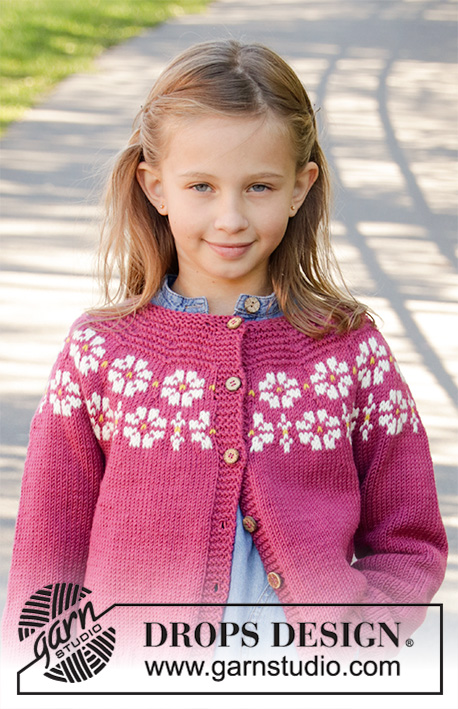
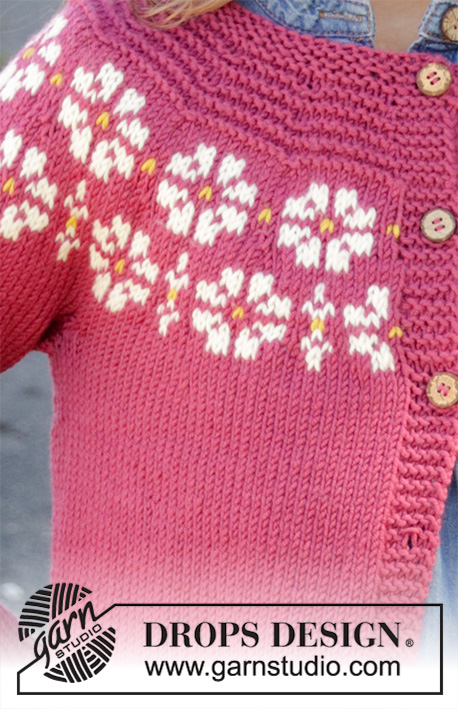


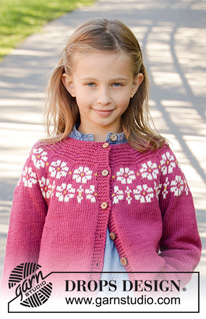





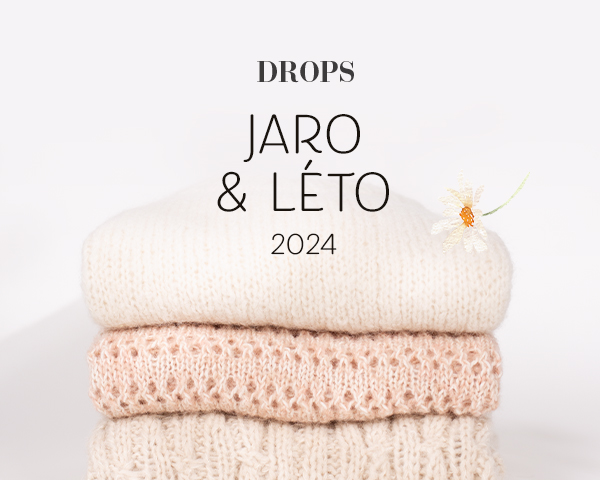








































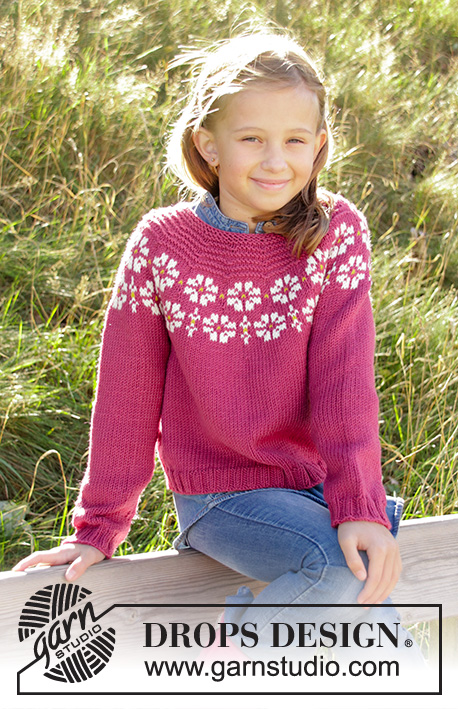






Komentáře / Otázky (31)
Bonjour, Je vais commencé le tricot du gilet mais je voulais savoir si je devais faire mon échantillon en rond ou bien à plat?! Merci. Cordialement. Stéphanie
21.03.2024 - 11:21DROPS Design answered:
Bonjour Stéphanie, le gilet va se tricoter en allers et retours, vous pouvez ainsi tricoter votre échantillon en rangs, veillez juste bien à conserver la même tension pour les manches, quand vous tricoterez en rond (vous pouvez du coup en faire un en rond si vous pensez avoir une façon différente de tricoter). Bon tricot!
21.03.2024 - 15:52Hello! Sleeve question- when knitting the sleeve, where do I do the measurements from? Is it along the underarm? I’m almost to the cuff.
25.02.2024 - 18:50DROPS Design answered:
Dear Mrs Casteneda, measure along mid top on sleeve from where you started sleeve, ie from after the division. Happy knitting!
26.02.2024 - 09:33Hello! I have a question regarding the Daisy Delight Cardigan. On the A.2 stitch chart, sizes 3/4-7/8, on the row that contains the last stitch increases (8 rows) from the top of the chart) there are two yarnovers that come between 2 colors of yarn. Which color do I use to do the yarnover with? The off-white or the heather? Thank you fir your help!
23.02.2024 - 03:03DROPS Design answered:
Hi Cathie, You use the background colour (heather) both to make the yarn overs and to work the new stitches on the next row. This maintains the shape of the white pattern. Happy knitting
23.02.2024 - 07:18Dobrý den, prosím kterou řadou se začíná? Líc nebo Rub? ...Děkuji
27.12.2023 - 14:50DROPS Design answered:
Dobrý den, Anno, 1. pletená řada je lícová. Přidávání (po dokončení 2 vroubků) je také v lícové řadě. Hodně zdaru! Hana
30.12.2023 - 09:01Can I use Paintbox Simply Aran DK yarn for this garment?
10.06.2023 - 04:57DROPS Design answered:
Dear Suzie Rose, we unfortunately do not know this yarn, you can use our yarn converter to get alternative and new amount - or you are welcome to ask the store where you bought your yarn; they should be able to help you even per mail or telephone. Happy knitting!
12.06.2023 - 09:40I am knitting the 7-8yr size but when starting the daisy pattern I only have 13 repeats not the 15 stated on the pattern - I have 179 stitches on row 18. I have started this twice and stil getting the same result. It's there something I'm doing wrong ? Many thanks
02.03.2023 - 17:31DROPS Design answered:
Dear Christine, in size 7/8 years there are 101 sts worked as follows, seen from RS: 5 front band sts, A.1 (= 1 st), then repeat the 6 sts in A.2 until 5 sts remain (= a total of 15 times), finish with 5 front band sts; Row 18 should be worked over 12 sts (6 sts have been increased before as shown in diagram, alternately at the end + at the beg of each A.2), so that you should have: 5 + 1 + (12x15) + 5 = 191 sts. When A.2 is done there are 16 sts in each A.2 and 251 sts in total. Adding marker between each A.2 might help you to check your number of stitches after every round. Happy knitting!
03.03.2023 - 08:52Please can you tell me how I know how many balls of wool to order for this pattern? Thank you. Julie
03.02.2023 - 08:51DROPS Design answered:
Hi Julie, if you choose for example size 7/8 years that means you will need the 3rd amount of each colour, counting from the left (under MATERIALS). Each ball weighs 50 g. Please see also the lesson DROPS HERE. Happy knitting!
03.02.2023 - 09:23Bonjour, Je fais le modèle en 9/10 ans. Je ne comprends pas ce que veut dire dans l’empiècement après 5 mailles de bordure devant au point mousse : A.1 au dessus de la maille suivante. (Que veut dire cette phrase) Comment procéder ? En vous remerciant Bonne journée
12.04.2022 - 17:33DROPS Design answered:
Bonjour Mme Varain, tricotez simplement la maille suivante en suivant le diagramme A.1 , autrement dit, sur l'endroit, terminez par A.1 avant la bordure devant et sur l'envers, commencez par A.1 après la bordure devant. Le motif sera ainsi symétrique. Bon tricot!
19.04.2022 - 08:54Hej, mina knapphål hamnar inte på mitten av de fem kantmaskorna. Det ser ut som att de ska vara i mitten på bilderna tycker jag. Gör jag fel?
03.02.2022 - 11:25DROPS Design answered:
Hej Karin. Du ska sticka ihop 2:a och 3:e maskan och sedan göra ett omslag och då ska knapphålet hamna i mitten av kantmaskorna. Mvh DROPS Design
04.02.2022 - 12:19Working on the child's cardigan, on row 22 of A.2. there is no white, only the yellow centers. Do you recommend I carry the white across row 22 from row 21 so it is in place for row 23, or stop/start the white over again on row 23. I see no other way to carry it up beyond carrying it across or cutting and restarting. Thanks for the advice and wonderful patterns.
15.10.2021 - 01:56DROPS Design answered:
Dear Mrs Miller, that's only 2 sts difference, you can carry the white yarn at the end of row 22 so that it's on the right place at the beg of row 23 or just carry the yarn 1 stitch before the first stitch in white at the beg of first A.2. Your yarn store might have even more tips for you, do not hesitate to ask them, even per mail or telephone. Happy knitting!
15.10.2021 - 08:07